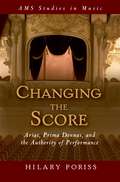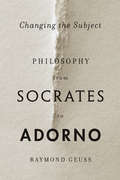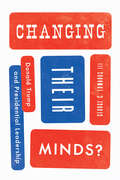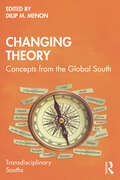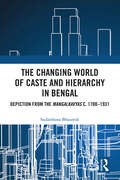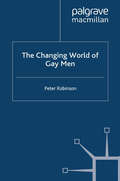- Table View
- List View
Changing the Scientific Study of Religion: Theoretical, Empirical and Clinical Studies from Psychoanalytic Perspectives
by Jacob A. V. Van BelzenThe psychoanalytic approach to religion has changed radically during the course of the twentieth century. In both clinical and theoretical work in psychoanalysis, developments have taken place that frequently are not noted by persons who assume that all that can be said has been said by Freud. The study of religious phenomena, persons, events and traditions has always been a substantial part of applied psychoanalysis and here also major developments have taken place. It is no exaggeration to state that the scientific study of religion has been revolutionized by the integration of psychological perspectives, including the field of psychoanalysis. This volume differs from other recent publications on the topic of psychoanalysis and religion in drawing upon the entire field of psychoanalytic involvement with religion. It is interdisciplinary in approach and unlike other books on the topic brings together an exceptional combination of theoretical, empirical and clinical studies. No other book provides integrated examples of all three types of work.
Changing the Score: Arias, Prima Donnas, and the Authority of Performance (AMS Studies in Music)
by Hilary PorissThis study seeks to explore the role and significance of aria insertion, the practice that allowed singers to introduce music of their own choice into productions of Italian operas. Each chapter investigates the art of aria insertion during the nineteenth century from varying perspectives, beginning with an overview of the changing fortunes of the practice, followed by explorations of individual prima donnas and their relationship with particular insertion arias: Carolina Ungher's difficulties in finding a "perfect" aria to introduce into Donizetti's Marino Faliero; Guiditta Pasta's performance of an aria from Pacini's Niobe in a variety of operas, and the subsequent fortunes of that particular aria; Maria Malibran's interpolation of Vaccai's final scene from Giulietta e Romeo in place of Bellini's original setting in his I Capuleti e i Montecchi; and Adelina Patti's "mini-concerts" in the lesson scene of Il barbiere di Siviglia. The final chapter provides a treatment of a short story, "Memoir of a Song," narrated by none other than an insertion aria itself, and the volume concludes with an appendix containing the first modern edition of this short story, a narrative that has lain utterly forgotten since its publication in 1849. This book covers a wide variety of material that will be of interest to opera scholars and opera lovers alike, touching on the fluidity of the operatic work, on the reception of the singers, and on the shifting and hardening aesthetics of music criticism through the period.
Changing the Subject: Philosophy from Socrates to Adorno
by Raymond GeussFor Raymond Geuss, philosophers’ attempts to bypass normal ways of thinking—to point out that the question being asked is itself misguided—represents philosophy at its best. By provoking people to think differently, philosophers make clear that we are not fated to live within the stifling systems of thought we inherit. We can change the subject.
Changing the Subject: Philosophy from Socrates to Adorno
by Raymond GeussFor Raymond Geuss, philosophers’ attempts to bypass normal ways of thinking—to point out that the question being asked is itself misguided—represents philosophy at its best. By provoking people to think differently, philosophers make clear that we are not fated to live within the stifling systems of thought we inherit. We can change the subject.
Changing the World: American Progressives in War and Revolution (PDF)
by Alan DawleyIn May of 1919, women from around the world gathered in Zurich, Switzerland, and proclaimed, "We dedicate ourselves to peace!" Just months after the end of World War I, the Womens International League for Peace and Freedom--a group led by American progressive Jane Addams and comprising veteran campaigners for social reform--knew that a peaceful world was essential to their ongoing quest for social and economic justice. Alan Dawley tells the story of American progressives during the decade spanning World War I and its aftermath. He shows how they laid the foundation for progressive internationalism in their efforts to improve the world both at home and abroad. Unlike other accounts of the progressive movement--and of American politics in general--this book fuses social and international history. Dawley shows how interventions in Latin America and Europe affected domestic plans for social reform and civic engagement, and he depicts internal battles among progressives between unabashed imperialists like Theodore Roosevelt and their implacable opponents like Robert La Follette. He draws a contrast between Woodrow Wilson's use of force in exporting American ideals and Addams's more cosmopolitan pursuit of economic justice and world peace. In discussing the debate over the League of Nations within the context of turbulent domestic affairs, Dawley brings keen insight into that complicated moment in American history. In striking and original ways, Dawley brings together domestic and world affairs to argue that American progressivism cannot be understood apart from its international context. Focusing on world-historical events of empire, revolution, war, and peace, he shows how American reformers invented a new politics built around progressive internationalism. Changing the World retrieves the progressive tradition in American politics and makes it available to contemporary debates. The book speaks to anyone seeking to be both a good citizen within the nation and a good citizen of today's troubled world.
Changing the World, Changing Oneself: Political Protest and Collective Identities in West Germany and the U.S. in the 1960s and 1970s (Protest, Culture & Society #3)
by Belinda Davis, Wilfried Mausbach, Martin Klimke, and Carla MacDougallA captivating time, the 60s and 70s now draw more attention than ever. The first substantial work by historians has appeared only in the last few years, and this volume offers an important contribution. These meticulously researched essays offer new perspectives on the Cold War and global relations in the 1960s and 70s through the perspective of the youth movements that shook the U.S., Western Europe, and beyond. These movements led to the transformation of diplomatic relations and domestic political cultures, as well as ideas about democracy and who best understood and promoted it. Bringing together scholars of several countries and many disciplines, this volume also uniquely features the reflections of former activists.
Changing Their Minds?: Donald Trump and Presidential Leadership
by George C. Edwards IIIDespite popular perceptions, presidents rarely succeed in persuading either the public or members of Congress to change their minds and move from opposition to particular policies to support of them. As a result, the White House is not able to alter the political landscape and create opportunities for change. Instead, successful presidents recognize and skillfully exploit the opportunities already found in their political environments. If they fail to understand their strategic positions, they are likely to overreach and experience political disaster. Donald Trump has been a distinctive president, and his arrival in the Oval Office brought new questions. Could someone with his decades of experience as a self-promoter connect with the public and win its support? Could a president who is an experienced negotiator obtain the support in Congress needed to pass his legislative programs? Would we need to adjust the theory of presidential leadership to accommodate a president with unique persuasive skills? Building on decades of research and employing extensive new data, George C. Edwards III addresses these questions. He finds that President Trump has been no different than other presidents in being constrained by his environment. He moved neither the public nor Congress. Even for an experienced salesman and dealmaker, presidential power is still not the power to persuade. Equally important was the fact that, as Edwards shows, Trump was not able to exploit the opportunities he had. In fact, we learn here that the patterns of the president’s rhetoric and communications and his approach to dealing with Congress ultimately lessened his chances of success. President Trump, it turns out, was often his own agenda’s undoing.
Changing Theory: Concepts from the Global South
by Dilip M. MenonThis book is an original, systematic, and radical attempt at decolonizing critical theory. Drawing on linguistic concepts from 16 languages from Asia, Africa, the Arab world, and South America, the essays in the volume explore the entailments of words while discussing their conceptual implications for the humanities and the social sciences everywhere. The essays engage in the work of thinking through words to generate a conceptual vocabulary that will allow for a global conversation on social theory which will be necessarily multilingual. With essays by scholars, across generations, and from a variety of disciplines – history, anthropology, and philosophy to literature and political theory – this book will be essential reading for scholars, researchers, and students of critical theory and the social sciences.
Changing Theory: Concepts from the Global South
by Dilip M. MenonThis book is an original, systematic, and radical attempt at decolonizing critical theory. Drawing on linguistic concepts from 16 languages from Asia, Africa, the Arab world, and South America, the essays in the volume explore the entailments of words while discussing their conceptual implications for the humanities and the social sciences everywhere. The essays engage in the work of thinking through words to generate a conceptual vocabulary that will allow for a global conversation on social theory which will be necessarily multilingual. With essays by scholars, across generations, and from a variety of disciplines – history, anthropology, and philosophy to literature and political theory – this book will be essential reading for scholars, researchers, and students of critical theory and the social sciences.
Changing Times: Economics, Policies, and Resource Allocation in Britain since 1951 (An Economic and Social History of Britain)
by Martin ChickThis is a study of how, and why, the British economy has changed since 1951. It covers the Golden Age of 1945-1973 when unemployment was below one million; when governments built millions of council houses and flats; when electricity, telephones, and gas were supplied by nationalised monopolies; when income and wealth inequality were narrowing; and when the UK was not a member of the European Economic Community. Moving through the inflation, rising unemployment, and rapid contraction of the manufacturing industry from the mid- 1970s, Changing Times examines the transfer of assets which was effected in the privatisation of public housing and nationalised industries from the early 1980s. The role of the State changed as public investment fell. The financing of old-age care, of state pensions, and of the National Health Service became of increasing concern and were less politically amenable to the approach of using private finance (the Private Finance Initiative and tuition fees) to fund former public obligations. Changes were made to the system of taxation, but public expenditure changed little as a share of national income, although the government now built little. Difficulties emerged in ensuring adequate housing for a growing population, and uncertainty grew as to where future investment in necessities like electricity supply would come from. Having narrowed in the Golden Age, inequality of income and wealth widened. Environmental concerns also grew, from the local smogs of the 1950s, through the concern with acid rain from the 1960s, to the current global concern with climate change. The financial crash of 2008 and the decision to 'Brexit' in the referendum of 2016 reduced economic growth and highlighted the extent of economic change since 1951. This is a study of that change.
Changing Times: Economics, Policies, and Resource Allocation in Britain since 1951 (An Economic and Social History of Britain)
by Martin ChickThis is a study of how, and why, the British economy has changed since 1951. It covers the Golden Age of 1945-1973 when unemployment was below one million; when governments built millions of council houses and flats; when electricity, telephones, and gas were supplied by nationalised monopolies; when income and wealth inequality were narrowing; and when the UK was not a member of the European Economic Community. Moving through the inflation, rising unemployment, and rapid contraction of the manufacturing industry from the mid- 1970s, Changing Times examines the transfer of assets which was effected in the privatisation of public housing and nationalised industries from the early 1980s. The role of the State changed as public investment fell. The financing of old-age care, of state pensions, and of the National Health Service became of increasing concern and were less politically amenable to the approach of using private finance (the Private Finance Initiative and tuition fees) to fund former public obligations. Changes were made to the system of taxation, but public expenditure changed little as a share of national income, although the government now built little. Difficulties emerged in ensuring adequate housing for a growing population, and uncertainty grew as to where future investment in necessities like electricity supply would come from. Having narrowed in the Golden Age, inequality of income and wealth widened. Environmental concerns also grew, from the local smogs of the 1950s, through the concern with acid rain from the 1960s, to the current global concern with climate change. The financial crash of 2008 and the decision to 'Brexit' in the referendum of 2016 reduced economic growth and highlighted the extent of economic change since 1951. This is a study of that change.
Changing Trends in China's Inequality: Evidence, Analysis, and Prospects
by Terry Sicular, Shi Li, Ximing Yue, Hiroshi SatoOver the past quarter-century China has seen a dramatic increase in income inequality, prompting a shift in China's development strategy and the adoption of an array of new policies to redistribute income, promote shared growth, and establish a social safety net. Drawing on of household-level data from the China Household Income Project, Changing Trends in China's Inequality provides an independent, comprehensive, and empirically grounded study of the evolution of incomes and inequality in China over time. Edited by leading experts on the Chinese economy, the volume analyzes this evolution in China as a whole as well as in the urban and rural sectors, with close attention to measurement issues and to shifts in the economy, institutions, and public policy. Specific essays provides analyses of China's wealth inequality, the emergence of a new middle class, the income gap between the Han majority and the ethnic minorities, the gender wage gap, and the impacts of government policies such as social welfare programs and the minimum wage.
Changing Trends in China's Inequality: Evidence, Analysis, and Prospects
Over the past quarter-century China has seen a dramatic increase in income inequality, prompting a shift in China's development strategy and the adoption of an array of new policies to redistribute income, promote shared growth, and establish a social safety net. Drawing on of household-level data from the China Household Income Project, Changing Trends in China's Inequality provides an independent, comprehensive, and empirically grounded study of the evolution of incomes and inequality in China over time. Edited by leading experts on the Chinese economy, the volume analyzes this evolution in China as a whole as well as in the urban and rural sectors, with close attention to measurement issues and to shifts in the economy, institutions, and public policy. Specific essays provides analyses of China's wealth inequality, the emergence of a new middle class, the income gap between the Han majority and the ethnic minorities, the gender wage gap, and the impacts of government policies such as social welfare programs and the minimum wage.
The Changing University: How Increased Demand for Scientists and Technology is Transforming Academic Institutions Internationally (NATO Science Series D: #59)
by Dorothy S. ZinbergThis collection of papers was written for a NATO Advanced Research Workshop held at Harvard University in March 1990. The title, "The Changing University and the Education of Scientists and Engineers: An International Workshop," broad as it is, does not convey the sweep of data, infonnation, opinions, and suggestions for future research and policy choices that were crowded into two-and-a-half days of fonnal presentations, mealtime discussions, and teatime chats. The proposal for the workshop grew out of a research project I had carried out that explored the policies governing the education of foreign science and engineering students (S&Es) in several industrialized countries, and of two countries that send large numbers of S&E students abroad - the People's Republic of China (PRC) and Japan (see chapter 7). In research visits to these countries as well as to France, the United Kingdom, West Gennany, and within the United States, I was struck by the similarity of issues that were raised. One was the concern that there would not be enough well-trained scientists and engineers to meet the constantly increasing demand for them. Government officials, industrialists, and educators repeatedly stressed that a well-educated and -motivated work force was essential for their economies, national security, and for society as a whole. Many of those interviewed mentioned that universities are undergoing rapid, systemic changes as governments and industry are calling on them to provide human resources and intellectual capital.
Changing Values and Identities in the Post-Communist World (Societies and Political Orders in Transition)
by Nadezhda Lebedeva Radosveta Dimitrova John BerryThis book offers a comparative analysis of value and identity changes in several post-Soviet countries. In light of the tremendous economic, social and political changes in former communist states, the authors compare the values, attitudes and identities of different generations and cultural groups. Based on extensive empirical data, using quantitative and qualitative methods to study complex social identities, this book examines how intergenerational value and identity changes are linked to socio-economic and political development. Topics include the rise of nationalist sentiments, identity formation of ethnic and religious groups and minorities, youth identity formation and intergenerational value conflicts.
Changing War: The British Army, the Hundred Days Campaign and The Birth of the Royal Air Force, 1918 (Birmingham War Studies)
by Gary Sheffield Peter GrayIn 1918, the British Expeditionary Force (BEF) played a critical role in defeating the German army and thus winning the First World War. This 'Hundred Days' campaign (August to November 1918) was the greatest series of land victories in British military history. 1918 also saw the creation of the Royal Air Force, the world's first independent air service, from the Royal Flying Corps and the Royal Naval Air Service. Until recently, British histories of the First World War have tended to concentrate on the earlier battles of 1916 and 1917 and often underplayed this vitally important period.Changing War fills this significant gap in our knowledge by providing in-depth examinations of key aspects of the operations of the British Army, the Royal Air Force and its antecedents in the climactic year of the First World War. Written by a group of established historians and emerging scholars it sheds light not only on 1918, but on the revolutionary changes in warfare that took place at that time.
Changing War: The British Army, the Hundred Days Campaign and The Birth of the Royal Air Force, 1918 (Birmingham War Studies #6)
by Gary Sheffield Peter GrayIn 1918, the British Expeditionary Force (BEF) played a critical role in defeating the German army and thus winning the First World War. This 'Hundred Days' campaign (August to November 1918) was the greatest series of land victories in British military history. 1918 also saw the creation of the Royal Air Force, the world's first independent air service, from the Royal Flying Corps and the Royal Naval Air Service. Until recently, British histories of the First World War have tended to concentrate on the earlier battles of 1916 and 1917 and often underplayed this vitally important period.Changing War fills this significant gap in our knowledge by providing in-depth examinations of key aspects of the operations of the British Army, the Royal Air Force and its antecedents in the climactic year of the First World War. Written by a group of established historians and emerging scholars it sheds light not only on 1918, but on the revolutionary changes in warfare that took place at that time.
Changing Woman: A History of Racial Ethnic Women in Modern America
by Karen AndersonWhile great strides have been made in documenting discrimination against women in America, our awareness of discrimination is due in large part to the efforts of a feminist movement dominated by middle-class white women, and is skewed to their experiences. Yet discrimination against racial ethnic women is in fact dramatically different--more complex and more widespread--and without a window into the lives of racial ethnic women our understanding of the full extent of discrimination against all women in America will be woefully inadequate. Now, in this illuminating volume, Karen Anderson offers the first book to examine the lives of women in the three main ethnic groups in the United States--Native American, Mexican American, and African American women--revealing the many ways in which these groups have suffered oppression, and the profound effects it has had on their lives. Here is a thought-provoking examination of the history of racial ethnic women, one which provides not only insight into their lives, but also a broader perception of the history, politics, and culture of the United States. For instance, Anderson examines the clash between Native American tribes and the U.S. government (particularly in the plains and in the West) and shows how the forced acculturation of Indian women caused the abandonment of traditional cultural values and roles (in many tribes, women held positions of power which they had to relinquish), subordination to and economic dependence on their husbands, and the loss of meaningful authority over their children. Ultimately, Indian women were forced into the labor market, the extended family was destroyed, and tribes were dispersed from the reservation and into the mainstream--all of which dramatically altered the woman's place in white society and within their own tribes. The book examines Mexican-American women, revealing that since U.S. job recruiters in Mexico have historically focused mostly on low-wage male workers, Mexicans have constituted a disproportionate number of the illegals entering the states, placing them in a highly vulnerable position. And even though Mexican-American women have in many instances achieved a measure of economic success, in their families they are still subject to constraints on their social and political autonomy at the hands of their husbands. And finally, Anderson cites a wealth of evidence to demonstrate that, in the years since World War II, African-American women have experienced dramatic changes in their social positions and political roles, and that the migration to large urban areas in the North simply heightened the conflict between homemaker and breadwinner already thrust upon them. Changing Woman provides the first history of women within each racial ethnic group, tracing the meager progress they have made right up to the present. Indeed, Anderson concludes that while white middle-class women have made strides toward liberation from male domination, women of color have not yet found, in feminism, any political remedy to their problems.
Changing Work and Community Identities in European Regions: Perspectives on the Past and Present (Identity Studies in the Social Sciences)
by John Kirk Sylvie Contrepois Steve JefferysThis book juxtaposes the experiences of regions that have lived or are living through industrial transition in coal-mining and manufacturing centres throughout Europe, opening the way to a deeper understanding of the intensity of change and of how work helps shape new identities.
The Changing World of a Bombay Muslim Community, 1870 - 1945
by Salima TyabjiMuslims formed a disparate and unwieldy community in Bombay in the nineteenth century. The Islam that was professedly held in common by various groups could barely provide a sense of unity or cohesion to people so widely diverse in terms of language, customs, and also of forms and practices of belief. By the middle of the nineteenth century, a class of wealthy ship owners, ship-builders, and merchants, belonging to the varied communities that constituted the city, of which Muslims formed an important part, had emerged. This class was outward-looking, modern, and generally reformist in outlook: Gujarati or Maharashtrian, its goals of social reform, education, as well as political awareness, were gradually beginning to be perceived as goals held across communities, and increasingly across different regions. The questions that were being raised in the social turmoil of the period amongst Hindus were over issues of female education, the age of marriage, widow remarriage, and female seclusion. These issues were not foreign to the Muslim community; and the part played by Muslim leaders in Bombay in discussing and negotiating them was not an insignificant one, taking into account the size and relative backwardness of the community. Within this context, this book traces the evolving identity of a Bombay family and its changing social and political views in the late nineteenth and early twentieth centuries, using three main sources: their family journals, an individual memoir/journal, and letters written home from Europe.
The Changing World of a Bombay Muslim Community, 1870 - 1945
by Salima TyabjiMuslims formed a disparate and unwieldy community in Bombay in the nineteenth century. The Islam that was professedly held in common by various groups could barely provide a sense of unity or cohesion to people so widely diverse in terms of language, customs, and also of forms and practices of belief. By the middle of the nineteenth century, a class of wealthy ship owners, ship-builders, and merchants, belonging to the varied communities that constituted the city, of which Muslims formed an important part, had emerged. This class was outward-looking, modern, and generally reformist in outlook: Gujarati or Maharashtrian, its goals of social reform, education, as well as political awareness, were gradually beginning to be perceived as goals held across communities, and increasingly across different regions. The questions that were being raised in the social turmoil of the period amongst Hindus were over issues of female education, the age of marriage, widow remarriage, and female seclusion. These issues were not foreign to the Muslim community; and the part played by Muslim leaders in Bombay in discussing and negotiating them was not an insignificant one, taking into account the size and relative backwardness of the community. Within this context, this book traces the evolving identity of a Bombay family and its changing social and political views in the late nineteenth and early twentieth centuries, using three main sources: their family journals, an individual memoir/journal, and letters written home from Europe.
The Changing World of Caste and Hierarchy in Bengal: Depiction from the Mangalkavyas c. 1700–1931
by Sudarshana BhaumikThis book challenges the prevalent assumptions of caste, hierarchy and social mobility in pre-colonial and colonial Bengal. It studies the writings of colonial ethnographers, Orientalist scholars, Christian missionaries and pre-colonial literary texts like the Mangalkavyas to show how the concept of caste emerged and argues that the jati order in Bengal was far from being a rigidly reified structure, but one which had room for spatial and social mobility. The volume highlights the processes through which popular myths and beliefs of the lower caste orders of Bengal were Sanskritized. It delineates the linkages between sedantized peasant culture and the emergence of new agricultural castes in colonial Bengal. Moreover, the author discusses a wide spectrum of issues like marginality and hierarchy, the spread of Brahmanical hegemony, the creation of deities and the process of Sanskritization, popular Saivism, the cult of Manasa in Bengal and the revolt of 1857 and the caste question. Rich in archival sources, this book will be an essential read for scholars and researchers of colonial history, Indian history, political sociology, caste studies, exclusion studies, cultural studies, social history, cultural history and South Asian studies, especially those interested in undivided Bengal.
The Changing World of Caste and Hierarchy in Bengal: Depiction from the Mangalkavyas c. 1700–1931
by Sudarshana BhaumikThis book challenges the prevalent assumptions of caste, hierarchy and social mobility in pre-colonial and colonial Bengal. It studies the writings of colonial ethnographers, Orientalist scholars, Christian missionaries and pre-colonial literary texts like the Mangalkavyas to show how the concept of caste emerged and argues that the jati order in Bengal was far from being a rigidly reified structure, but one which had room for spatial and social mobility. The volume highlights the processes through which popular myths and beliefs of the lower caste orders of Bengal were Sanskritized. It delineates the linkages between sedantized peasant culture and the emergence of new agricultural castes in colonial Bengal. Moreover, the author discusses a wide spectrum of issues like marginality and hierarchy, the spread of Brahmanical hegemony, the creation of deities and the process of Sanskritization, popular Saivism, the cult of Manasa in Bengal and the revolt of 1857 and the caste question. Rich in archival sources, this book will be an essential read for scholars and researchers of colonial history, Indian history, political sociology, caste studies, exclusion studies, cultural studies, social history, cultural history and South Asian studies, especially those interested in undivided Bengal.
The Changing World of Gay Men
by P. RobinsonThis ground-breaking book explores the experiences of gay men and their understanding of what it meant to be gay in the 20th Century: from when homosexuality was illegal though the less repressed but no less difficult eras of gay liberation and the HIV-AIDS epidemic.
The Changjiang River Civilization: Nature and Culture of the Changjiang River from a Global Perspective (Understanding China)
by Tianyu Feng Zhiliang Ma Yuan DingThis book is a comprehensive academic introduction of the natural conditions and cultural characteristics of the ChangJiang River Basin. Describing in detail the geographical location and natural conditions of the main stream and the tributaries as the starting point, the book compares the ChangJiang River Civilizations to other civilizations of large rivers of the same latitude. This book reveals the gradual deepening of the Chinese understanding the ChangJiang River, introduces the cultural divisions of the river valley, and describes the evolution of the civilizations in the basin. At the end of the book, the author points out that there are many ecological problems in the ChangJiang River valley, for which the Chinese people have taken many measures, such as water pollution control. Fishing in the main stream and important tributaries of the ChangJiang is banned for at least ten years. As a guide to analyze the natural conditions and cultural characteristics of the whole ChangJiang River Basin, this book enables researchers and common readers to have a relatively clear and comprehensive understanding in a relatively short period of time. Putting the ChangJiang River Civilization in the context of the world’s civilizations, this book makes it easier for readers to understand the uniqueness of the ChangJiang River Civilization and its contribution to the cultural diversity of the world.

